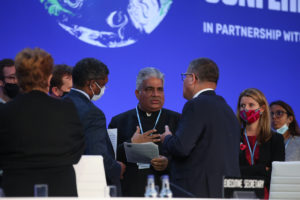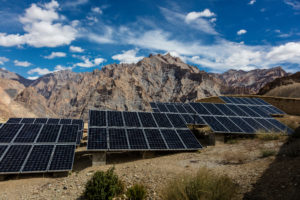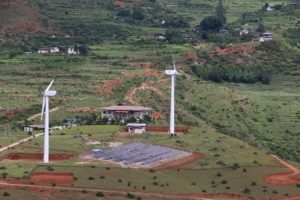The Modi administration has bet its reputation as a future climate champion on the fast deployment of an amount of solar that was unthinkable just 10 years ago. In 2010, India’s solar capacity was just over 11 MW. Today, it is 40 GW, which the government expects will increase sevenfold to 280GW of installed solar by the end of the decade.
The success of such an ambitious target hinges on harnessing the potential of solar energy everywhere, not just in deserts that can easily be turned into solar parks. And so far, India has been neglecting the next most promising space to install solar: roofs.
A combination of a transparent investment environment and the availability of cheap technologies imported from China has enabled solar’s fast progress to date. But large-scale solar, the main driver of growth so far, faces new challenges that may hold back its expansion. Land to deploy vast arrays of panels is not as abundant as it was just five years ago, the water necessary to keep the panels clean is becoming scarcer, and policy bottlenecks between central and state governments have dented investors’ confidence. While a modest slowdown of large-scale solar development is to be expected and is unlikely to damage India’s solar outlook in the long term, it could derail the target of increasing existing non-fossil fuel capacity to 500 GW by 2030, announced by Prime Minister Narendra Modi at COP26.
Rooftop solar in India has huge untapped potential
Tapping into the potential of rooftop solar may be key to achieving India’s renewable goals. So far, India has installed 6.7 GW of panels on rooftops – falling far short of its target of 40 GW by this year. But according to analysts who have created a global map of rooftop solar potential, the country is the best placed in the world to generate the greatest amount of electricity at the lowest price.
While large solar parks are owned by big energy firms that dispatch power through distribution companies, rooftop solar is decentralised. Even small households can generate and deliver their own electricity directly where it’s used, reducing their reliance on the main power grid.
If the government is serious about solar and meeting its renewable targets, it should delay the rollout of the basic custom duties on solar equipment from ChinaVibhuti Garg, Institute for Energy Economics and Financial Analysis
Despite its potential, the Indian rooftop market remains under-penetrated in comparison with most solar markets around the world, says Vinay Rustagi, managing director of the consultancy Bridge to India. This is “mainly due to a volatile policy environment and lack of awareness among consumers”.
Subrahmanyam Pulipaka, chief executive of industry association the National Solar Energy Federation of India (NSEFI), is optimistic. “In 2021, our rooftop installations doubled,” he says, “however we are still well below the mark and we can do much better with the right policies in place.” Pulipaka explains that the pandemic brought the deployment of large-scale solar to a halt, while residential and industrial demand for decentralised solar increased. This trend is expected to continue well beyond the end of lockdowns, with an additional 4-5 GW a year, he says.
Political bottlenecks
Others are less confident that the right policies will materialise. Vibhuti Garg, energy economist at thinktank the Institute for Energy Economics and Financial Analysis (IEEFA), points out that allowing customers to install net-meters along with their panels, which enable them to sell excess power produced to the grid, is essential for the sector to take off. But the government putting very stringent caps on net-metering, allowing only the smallest units of up to 10 kW capacity to qualify, has “all but killed the solar rooftop market”.
What is a net-meter?
A device that monitors how much energy is put back into the grid from solar units, and how much is taken from the grid. It calculates whether the consumer uses more energy than the solar panels produce.
India provides electricity to farmers almost free of charge, and at a very low rate to urban residents. Commercial enterprises and industries pay the highest price for electricity, subsidising the rest of the population. This makes sense on paper: agriculture is the backbone of India’s economy and most farmers need support to run their businesses, while many city dwellers cannot afford high bills.
But in practice, it means that residents have few incentives to switch to renewable energy, because they would have to shoulder the upfront cost of solar panels or navigate confusing subsidies schemes. In other countries, Rustagi says, the financial viability of rooftop solar is much better because of high grid tariffs. “This means that consumers have a very strong incentive to go for rooftop solar, and hence whatever extra effort they need to make is justified.”
Building an appetite for rooftop solar won’t be quick or easy, Rustagi says. But he hopes that over time prices will fall and awareness will improve. “Right now, people don’t know any of their friends or neighbours who have installed a rooftop solar system,” he says, “but in three to four years, as the installed base increases, they will find out more through word of mouth, and that will drive the decision to go forward.”
Due to its money-saving potential, adopting renewables is already an attractive idea for industries and commercial enterprises. But India’s energy distribution system, which is chronically on the brink of bankruptcy, needs them to pay their high bills to stay afloat. For this reason, states are reluctant to mainstream net-metering and this is unlikely to change in 2022, despite the urgency of fast-tracking solar uptake across the country.
What’s in India’s next budget for rooftop solar?
India is currently awaiting the launch of its annual budget on 1 February. Garg says this is unlikely to address issues of clean energy distribution. But she is hopeful that the government will at least hit the brakes on other measures that are damaging the uptake of rooftop solar, in particular the basic custom duties that make it more expensive to buy solar modules from China.
Indian manufacturers can currently only provide a fraction of the solar equipment needed domestically, and cannot compete with the more advanced products China already manufactures. Taxing imports hurts the sector at large. Garg says that “if the government is serious about solar and meeting its renewable targets, it should [delay the rollout of the basic custom duties] because domestic manufacturing cannot and hasn’t picked up.”a
This article was first published by Lights On









